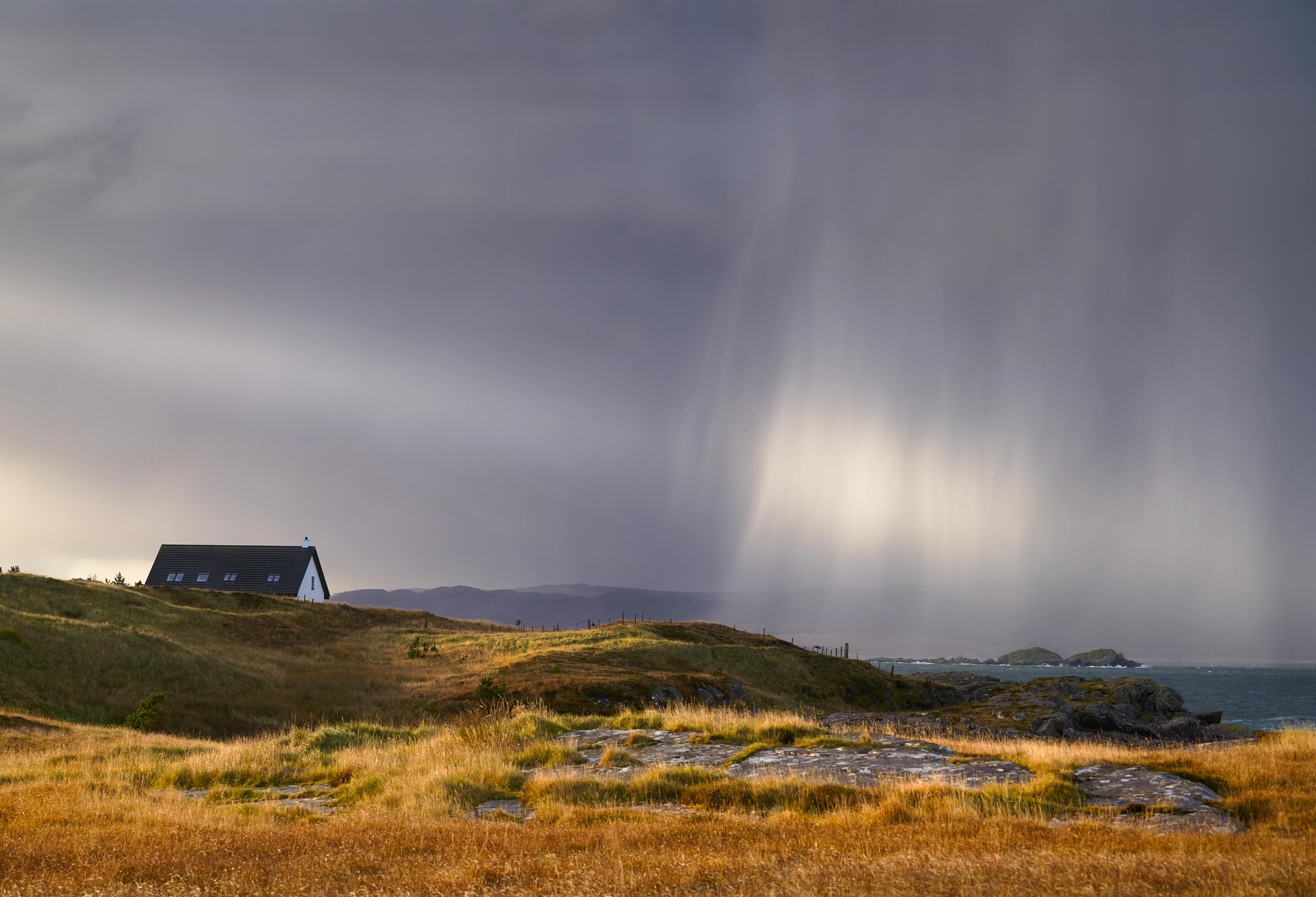Curious Question: How do waves shape our coastline?
Whether constructive or destructive, waves (some as high as four double-decker buses) claw at our shores in a frenzy of energy, observes Annemarie Munro.


As you look out to sea, the breath of a Puerto Rican blowing on his hot morning coffee travels without interruption to the shores of the British Isles to ruffle your hair. The breezes that blow through the fronds of the palm trees lining the sandy beaches of Martinique in the West Indies transfer energy into the water to create waves of power that surge unimpeded to our western shores.
Waves shape our island. They eat into the land on our eastern coast and shift the chewed-up land around to the western coastlines, spitting it out at the wide sandy beaches of Devon and Cornwall. There is no better way to understand how we are all connected globally to the interaction between wind, energy and topography than to watch the waves.
How many of you have visited the shores, walking briskly as you listen to music through headphones, exercising the dogs as you plan the week’s menu or marching beside a friend to catch up on news and gossip? We feel better for it, even if, once home, we have no clear memory of the beach itself. We are often too busy and distracted to notice the tide or the signature chatter of each wave, but what should we be noticing about the waves?
First, watch how the waves roll in towards the beach. They gain height, swell like heavily pregnant bellies; skin stretched tight, yearning to give birth as they push on towards the shore. The energy from the wind of Martinique has bowled across the deep Atlantic Ocean uninterrupted. Here, as the land shallows, the base of the ball of energy drags against the seabed. Tripped up, like a bully’s meanly placed foot in a school playground, the waves rear up and topple forward into a chaos of noise and foam, dragging at pebbles or sand in a clawing frenzy of dispersing energy.
Tripped up, waves rear up and topple forwards into a chaos of noise and foam
The impact of the wave is dependent on whether it is constructive or destructive. A constructive wave is low and shallow, washing energetically up towards your toes, to then sink slowly back from you like a shy dog, keen to lick you, but unsure of your reaction. As it rushes forwards, it pushes beach material up the shore, building it up and creating a large wide beach that protects the coastline beyond.
A destructive wave is a tall, rearing, cobra-like one that crashes forwards with a snarl of white water; the gnashing teeth of a predator pouncing on its prey, dragging the poor beast back into its jaws to feast in hunger. There is no pushing of material up the beach, but a poaching of material seawards, back into the belly of the surf. This scouring effect can leave the coastline vulnerable, as the land loses its line of defence — the beach.

To distinguish whether waves are constructive or destructive, you must note if the beach has a steep or gentle gradient. Steep beaches create destructive waves, which will be higher and crash nearer to you if you are paddling; expect constructive waves on a wide, flat sandy bay, where the waves are shallow and break far from you. If you live near a flat sandy beach, you are more protected from coastal erosion than if you live by a steep one.
Exquisite houses, the beauty of Nature, and how to get the most from your life, straight to your inbox.
Destructive waves play a role in causing the coastline to retreat through coastal erosion. It is a natural process of destruction and renewal, but becomes a human problem as we like to build houses named Seaview.
Rises in sea level can cause a change in the pattern of waves and the profile of our beaches — more are becoming steeper. The Marine Climate Change Impacts Partnership (MCCIP) estimates that 17% of the UK coastline (30% of England’s coastline; 23% Wales; 20% Northern Ireland; 12% Scotland) is prone to erosion.
As waves appear to have patterns, but do not, so our coastline seems static, but is not
A wave is the perfect thief. Imagine a fine day. The wave will distract the onlooker with its pomp of sparkling sapphire, sky-reflected gown and white frills of crowning surf, as it snatches the sand from under your feet. It steals sand from one beach and deposits it on another.
In many places, waves will approach at an angle to the shoreline, breaking at one end first and unravelling along to the other end of the beach. Take the Holderness Coast in the East Riding of Yorkshire, where prevailing winds create a north-easterly current that causes waves to break at a 45 ̊ angle from the shore. Sand and pebbles will be moved along the beach with each breaking wave, shunted across the beach and dropped as the water loses its energy and retreats down the slope, before another sideways swipe takes the material along further. Sand can, in this way, travel along the coastline, robbed from one spot to be received as stolen goods at another.
Waves, constructive or destructive, break constantly along our shores. The size of each wave, however, can vary. Have you ever seen surfers sitting out on their boards, sometimes for an hour or so, before riding their chosen wave to the beach? They are not sunbathing. They are waiting to catch the ‘right one’.

Many surfers will refer to waves coming in sets, a few large ones (from five to 12), then a lull before another ‘set’ of larger waves, although science has decreed this is a myth. There is no ‘set’, as there is no pattern.
The size of the waves constantly changes due to a range of influences, such as local wind strength, duration, the distance the wind has travelled, depth of the seabed and tides. Yet, as we see patterns in the randomly distributed stars above, so we, as humans, like to find a pattern in the randomness of waves.
It is true that there will be a volley of large waves crashing noisily, then a quiet time before the next series of larger ones; it is hard not to call it a pattern.
Knowing a little about waves can attune us to how waves shape our coastline. Ridges of boulders or sea walls are designed to limit the damage of destructive waves, whereas a croissant-shaped spit of sand is often there because stolen beach material has been interrupted by a river estuary and deposited there by constructive waves.
A beach is only as you see it at that moment in time. It appears to be a fixed part of our landscape, but that is an illusion. As waves appear to have patterns, but do not, so our coastline seems to be static, but is not. It is an ever-changing interaction between wind, water and land — and us.
Making waves
• Waves are made of energy moving through the water — the water itself rocks and spins with the disturbance, but does not move across the oceans • Deep waves developing out to sea are called swells — the longer between swells, the bigger the waves • The tallest wave recorded in UK waters was 62ft high (four stacked double-decker buses), recorded off the Scottish coast in 2013 • The largest boulders recorded to be moved by storm waves — off the coast of the west of Ireland in the winter of 2013/14 — weighed an incredible 560 tons
Time and tide
• Tides are not caused by wind, but the moon. The moon sucks the water towards it under gravitational force, making it bulge on opposite sides of the earth. The tides ebb and flow in a pattern matching the moon’s monthly cycle of the earth. When the sun and the full moon are aligned, they create extra high and low ‘spring’ tides • Coastal areas experience two high and two low tides every 24 hours and 50 minutes • The greatest tidal range (distance between high and low tide) is in the Bristol Channel, second only in the world to the Bay of Fundy, Nova Scotia, Canada • People cut off by the tide in the RNLI’s Wales and north-west of England region last year led to the charity’s life-boats being launched 115 times

Curious Questions: Which bird's song is loudest?
We tend to think of bird song as endearing and delicate — but there are birds out there who would put

Credit: Getty Images/iStockphoto
Curious Questions: When were dogs domesticated?
Dogs have never been more popular — as soaring puppy prices (and the worrying number of scams) show. But our

Curious Questions: Who invented the weather forecast?
Martin Fone tells the fascinating — and ultimately heartbreaking — tale of Robert Fitzroy, the visionary sailor-turned-scientist whose pioneering work saved
Country Life is unlike any other magazine: the only glossy weekly on the newsstand and the only magazine that has been guest-edited by His Majesty The King not once, but twice. It is a celebration of modern rural life and all its diverse joys and pleasures — that was first published in Queen Victoria's Diamond Jubilee year. Our eclectic mixture of witty and informative content — from the most up-to-date property news and commentary and a coveted glimpse inside some of the UK's best houses and gardens, to gardening, the arts and interior design, written by experts in their field — still cannot be found in print or online, anywhere else.
